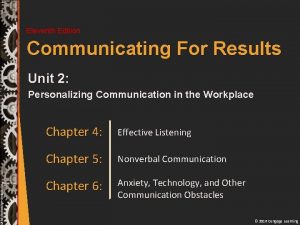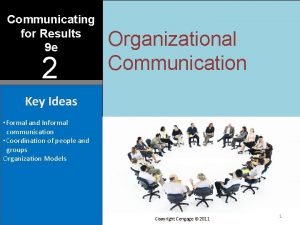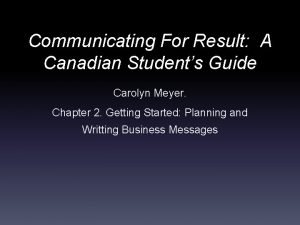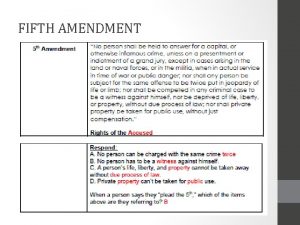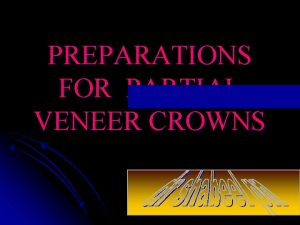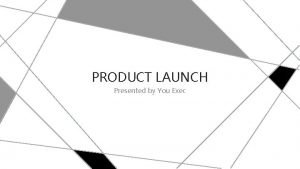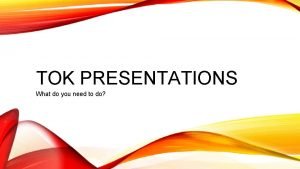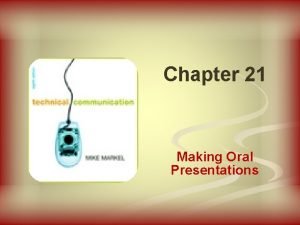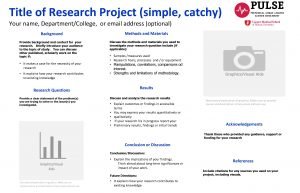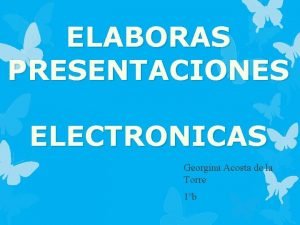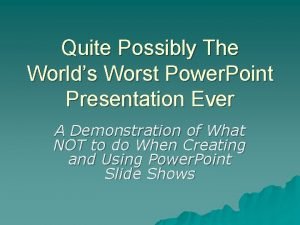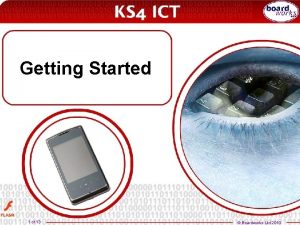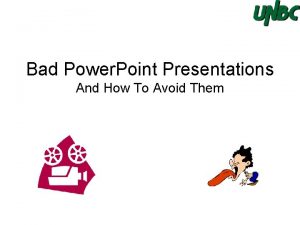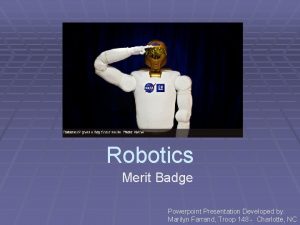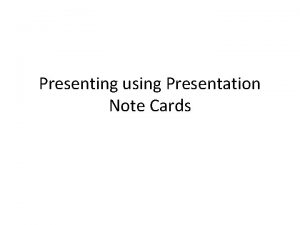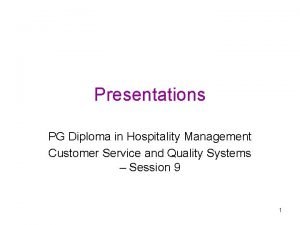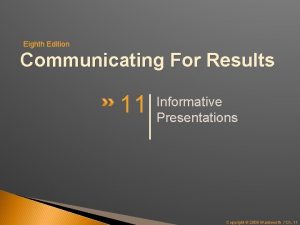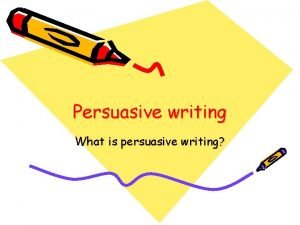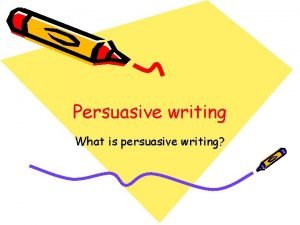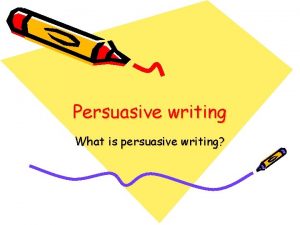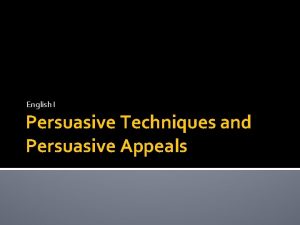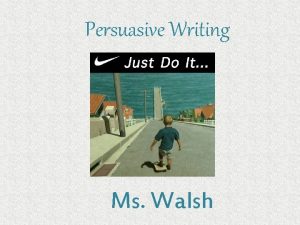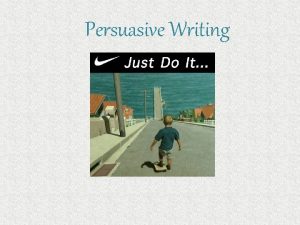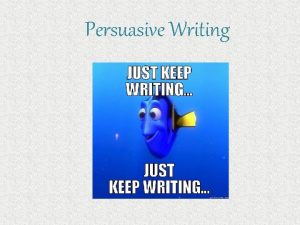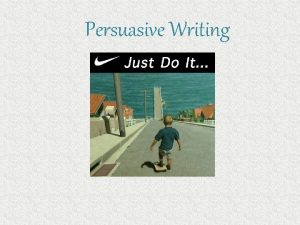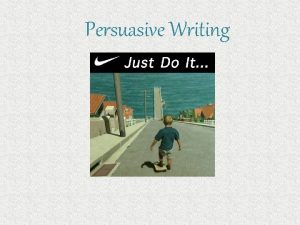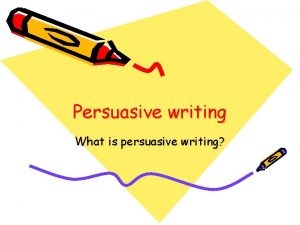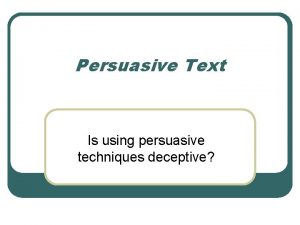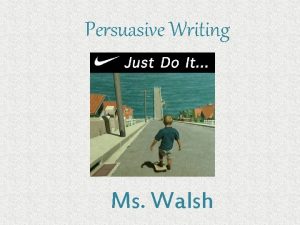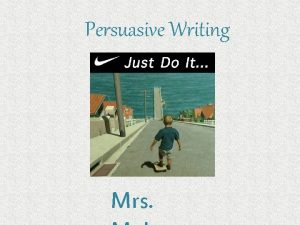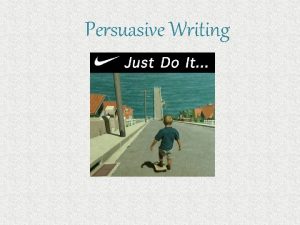Eighth Edition Communicating For Results 14 Persuasive Presentations











































- Slides: 43

Eighth Edition Communicating For Results 14 Persuasive Presentations: Individual or Team Copyright © 2008 Wadsworth / Ch. 14

14 Opening Quotation Williams & Cooler, Power Persuasion, Alistair, 1002, p. 3 Copyright © 2008 Wadsworth / Ch. 14

The Washington Post Rough Guides/Alamy Cooke: Case Study Read or describe the case study Answer the following questions: --Why were Cooke’s editors so easily by her resume & story? persuaded --Was the “instant ethos” response involved this study (pp. 407 -408)? -- Other observations? in Copyright © 2008 Wadsworth / Ch. 14

Persuasive Definitions & Types Copyright © 2008 Wadsworth / Ch. 14

Persuasion Defined “Persuasion is communication intended to influence choice” --It is intentional Vince Bucci/Getty Images --It involves influence, not force --It limits the options perceived as acceptable Copyright © 2008 Wadsworth / Ch. 14

Persuasive Presentations Basic types include. . . Speech to convince—asks the audience to believe or agree with you Speech to actuate—asks the audience to 2003 Laura Farr/ZUMA Press take a particular action Copyright © 2008 Wadsworth / Ch. 14

Persuasive Theory Copyright © 2008 Wadsworth / Ch. 14

Persuasive Theories Information-Integration Theory Copyright © 2008 Wadsworth / Ch. 14

Persuasive Theories Information-Integration Theory Consistency Theories Copyright © 2008 Wadsworth / Ch. 14

Persuasive Theories Information-Integration Theory Consistency Theories Elaboration Likelihood Theory More on ELM. . . Copyright © 2008 Wadsworth / Ch. 14

Persuasive Theories Information-Integration Theory Consistency Theories Elaboration Likelihood Theory (cont. ) Copyright © 2008 Wadsworth / Ch. 14

Persuasive Theories Information-Integration Theory Consistency Theories Elaboration Likelihood Theory Social Judgment Theory Copyright © 2008 Wadsworth / Ch. 14

Persuasive Factors Copyright © 2008 Wadsworth / Ch. 14

Persuasive Factors ic g lo s) o g & o e e (l c n sag e id es v E m of Op inio ns Key of Pe opl e Psychological Needs of listeners (pathos) All 4 are needed for persuasion. . . Copyright © 2008 Wadsworth / Ch. 14

Evidence & Logic Methods of using evidence include. . . Method 1: 1 Assertion plus evidence plus source Method 2: Assertion plus evidence Method 3: Assertion plus evidence plus source plus qualifications of source © Peter Chapman Method 4: Assertion plus firsthand experience Copyright © 2008 Wadsworth / Ch. 14

One Side of Argument Present one side when listeners. . . Already agree with proposal Know little about topic Are asked to take immediate action Are unlikely to hear other side One Side Copyright © 2008 Wadsworth / Ch. 14

Both Sides of Argument Present both sides of argument when listeners. . . Are knowledgeable Already disagree Likely to hear both sides Agree, but new to position or belief Side #1 Side #2 Copyright © 2008 Wadsworth / Ch. 14

False Reasoning Ad hominem--attacking person not argument Ad populum--everyone knows idea is right Ad Ignoratiam--can’t prove wrong; must be right Begging the question--it is because it is Hasty generalization--based on too few examples Post hoc--B followed A; therefore, A caused B Slippery slope--one bad step leads to another Copyright © 2008 Wadsworth / Ch. 14

Credibility of Speaker Credibility results from the following basic elements. . . Trustworthiness Competency Objectivity Organizational rank Image Source Limited/Index Stock Imagery Dynamism Copyright © 2008 Wadsworth / Ch. 14

Credibility & the Internet fraud based on the following “click-whir” responses. . . Reciprocation—feel obligated to reciprocate Commitment & consistency—defend decisions Social proof—if others do it, it must be right Likeability—more influenced by people we like Authority—influenced by those with authority © Jason Harris Scarcity—value scarce items more Copyright © 2008 Wadsworth / Ch. 14

Psychology Needs Maslow’s basic hierarchy of needs. . . Self-actualization Esteem Social Listener’s concern Safety Successful approach Successful speakers relate evidence & arguments to at least two specific audience needs Physiological Copyright © 2008 Wadsworth / Ch. 14

Opinions of Key Listeners Opinions leaders are. . . Better educated & influential More knowledgeable in important areas NOVA Development More likely to converse Copyright © 2008 Wadsworth / Ch. 14

Persuasive Presentation Steps Copyright © 2008 Wadsworth / Ch. 14

Persuasive Preparation Steps include. . . 1. 2. 3. 4. 5. 6. Analyze audience Write purpose as position statement Analyze your credibility Research topic Select best organizational pattern Complete outline or storyboards (to check supports, introduction, & conclusion) 7. Make sure presentation is ethical 8. Practice using visual aids Copyright © 2008 Wadsworth / Ch. 14

Attitude Poll Use poll to survey attitudes of audience well before presentation. . . Topic: Position statement: Strongly Disagree No Opinion Agree Strongly Agree Copyright © 2008 Wadsworth / Ch. 14

Persuasive Patterns Select one of the following organization patterns. . . Claim Copyright © 2008 Wadsworth / Ch. 14

Copyright © 2008 Wadsworth / Ch. 14

Persuasive Patterns Select & prepare one of the following organizational patterns. . . Claim Causal Copyright © 2008 Wadsworth / Ch. 14

Copyright © 2008 Wadsworth / Ch. 14

Persuasive Patterns Select & prepare one of the following organizational patterns. . . Claim Causal Problem Solution Copyright © 2008 Wadsworth / Ch. 14

Copyright © 2008 Wadsworth / Ch. 14

Persuasive Patterns Select & prepare one of the following organizational patterns. . . Claim Causal Problem-Solution Criteria Satisfaction Copyright © 2008 Wadsworth / Ch. 14

Copyright © 2008 Wadsworth / Ch. 14

Persuasive Patterns Select & prepare one of the following organizational patterns. . . Claim Causal Problem-Solution Criteria Satisfaction Comparative Advantages Copyright © 2008 Wadsworth / Ch. 14

Copyright © 2008 Wadsworth / Ch. 14

Persuasive Patterns Select & prepare one of the following organizational patterns. . . Claim Causal Problem-Solution Criteria Satisfaction Comparative Advantages Motivated Sequence I. Attention Step II. Need Step III. Satisfaction Step IV. Visualization Step V. Action Step Motivated Sequence Copyright © 2008 Wadsworth / Ch. 14

Copyright © 2008 Wadsworth / Ch. 14

Team Presentations Copyright © 2008 Wadsworth / Ch. 14

Effective Team Presentations Basic characteristics include. . . Content: Organized, supported, & smooth Visuals: Creative, professional, & effective © Roger Persson Delivery: Smooth, polished, & dynamic Copyright © 2008 Wadsworth / Ch. 14

Teams Adapt to Media Suggestions include. . . Don’t wear white or sharp contrast clothing Avoid stripes, polka dots, & patterns Avoid warm or hot colors Wear lightweight fabrics Wear “slenderizing” clothing Avoid shiny jewelry or shiny clothing Women wear regular makeup Copyright © 2008 Wadsworth / Ch. 14

14 Awareness Check Identifying Basic Needs. . . Copyright © 2008 Wadsworth / Ch. 14

14 Presentation Listen & evaluate Sean’s persuasive speech, “Untreated Depression in America. ” Copyright © 2008 Wadsworth / Ch. 14

14 The End Copyright © 2008 Wadsworth / Ch. 14
 Communicating for results 11th edition
Communicating for results 11th edition Communicating for results 11th edition
Communicating for results 11th edition Silk glove sign procedure
Silk glove sign procedure Psychology eighth edition david g myers
Psychology eighth edition david g myers David g myers psychology 8th edition
David g myers psychology 8th edition Operations management eighth edition
Operations management eighth edition Communicating for results
Communicating for results Seventh amendment meaning
Seventh amendment meaning Quarter inch fraction
Quarter inch fraction Mesial half crown preparation
Mesial half crown preparation The fifth, sixth, seventh, and eighth amendments protect *
The fifth, sixth, seventh, and eighth amendments protect * Eighth letter of the alphabet
Eighth letter of the alphabet Eighth amendment excessive bail
Eighth amendment excessive bail Anagram of eighth
Anagram of eighth What is the eighth commandment catholic
What is the eighth commandment catholic Criminal justice lesson
Criminal justice lesson Eighth planet from the sun
Eighth planet from the sun Taj mahal wonder of the world
Taj mahal wonder of the world Using mis (10th edition) 10th edition
Using mis (10th edition) 10th edition Using mis (10th edition)
Using mis (10th edition) Youexec
Youexec Useful phrases for presentations
Useful phrases for presentations Ria seminar system
Ria seminar system How to make a tok presentation
How to make a tok presentation Titles for mental health presentation
Titles for mental health presentation Types of oral presentations
Types of oral presentations Catalyst 37xx stack
Catalyst 37xx stack Research project name
Research project name Who is lazarus in the most dangerous game
Who is lazarus in the most dangerous game Corel presentations ventajas
Corel presentations ventajas Roof ppt presentations
Roof ppt presentations Efficient elements powerpoint
Efficient elements powerpoint Best and worst powerpoint presentations
Best and worst powerpoint presentations Boardworks flash
Boardworks flash Worst powerpoint presentation
Worst powerpoint presentation Bad powerpoint presentations examples
Bad powerpoint presentations examples Robotics merit badge answers
Robotics merit badge answers Note card for presentation
Note card for presentation Designing and delivering oral and online presentation
Designing and delivering oral and online presentation Www.yoursite.com
Www.yoursite.com You exec presentation
You exec presentation Minto situation complication
Minto situation complication To maintain audience interest in a multimedia presentation
To maintain audience interest in a multimedia presentation Customer service presentations
Customer service presentations
